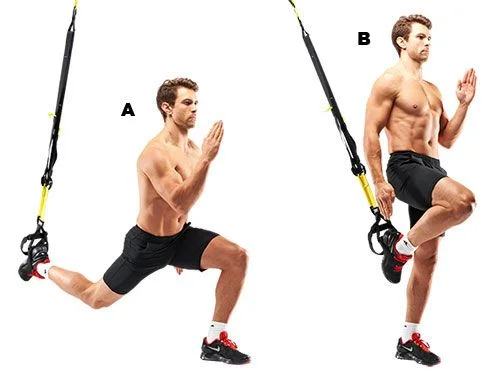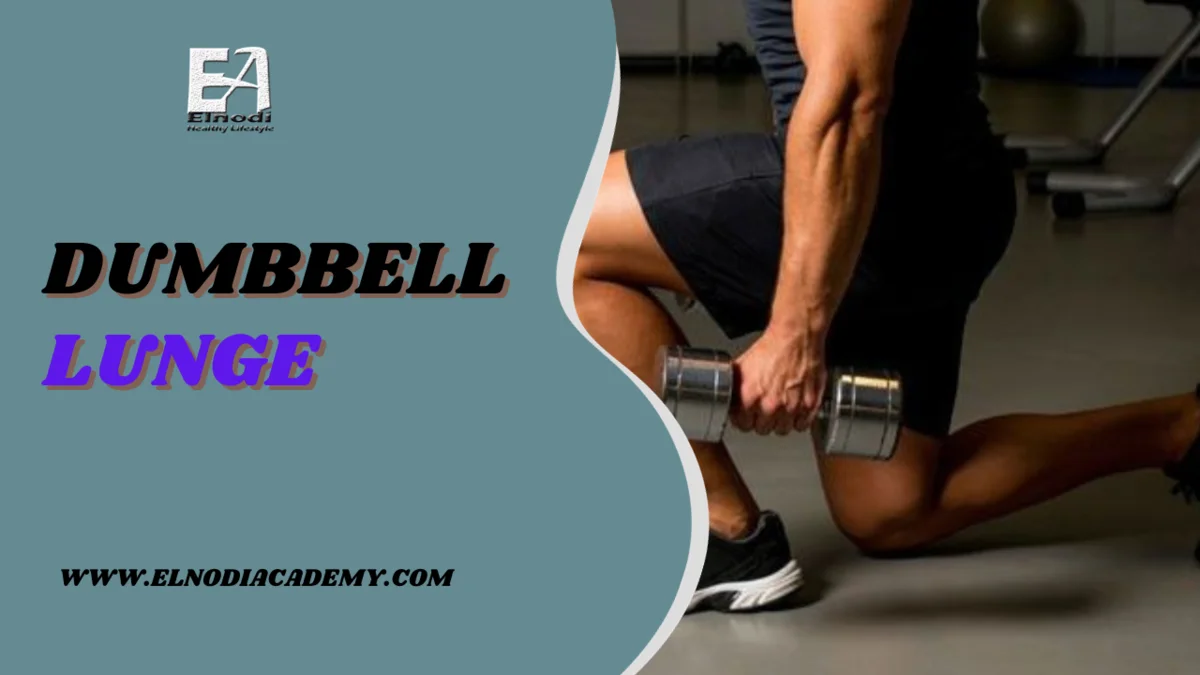The Dumbbell Walking Lunge is a great way to add variety to your routine and ultimately achieve greater results. If you’re looking to stay mobile and enhance your muscularity while burning enough calories to prepare for an active lifestyle, give this exercise a try.
Get started with Dumbbell Walking Lunges today – this simple exercise is a great way to sculpt your abdominal muscles and tone your thighs.
What Is a Dumbbell Walking Lunge?
The Dumbbell Walking Lunge is a single-leg lower-body workout that uses dumbbells to improve strength, power, and balance. This exercise adds weight to the alternating conventional lunge, which closely resembles the gait pattern.
Dumbbell Walking Lunge benefits
Combat Strength and Muscle Asymmetries
Unilateral training is essential for lower leg development and training. Increases in unilateral muscle development, strength, and coordination can lead to improvements in bilateral performance, muscular activation, and growth. When you focus on one leg at a time, you can reduce strength and muscular asymmetries that can lead to plateaus or injury. (1)
Increase Hypertrophy
The dumbbell lunge is an excellent workout for adding quality muscle hypertrophy to the lower body because it targets your lower body with potentially high volume. Changing the variations, tempos, and training schemes (reps and sets) will assist in promoting muscular growth from lunges even more.
Increase Knee and Hip Stability to Boost Injury Prevention
Injuries are frequently caused by unilateral movement asymmetries and muscle imbalances. This can occur as a result of inadequate movement patterning and compensations that emerge while just performing bilateral workouts. Dumbbell lunges, for example, can assist in improving unilateral coordination, balance, and performance – and so help prevent injury. (2)
Improve Sports Performance
Unilateral and multi-directional lunging (side, reverse, walking, diagonal, etc.) are essential for developing joint mobility, coordination, and movement development whether you are a runner, sprinter, or multi-sport athlete. You’ll gain a more intuitive awareness of where your body is and how it moves in space, which will help you in whatever sport you play.
dumbbell walking lunge muscles worked
Primary muscles worked:
- Glutes
- Quads
- Adductors
Secondary muscles worked:
- Forearm Flexors
dumbbell walking lunge form
How To do dumbbell walking lunge correctly
Instructions
- Position yourself with your feet shoulder-width apart and a dumbbell in each arm.
- Step forward with one leg, allowing both knees to bend at the same time.
- Descend till your back knee is on the floor.
- As you get up fully and return to the starting position, drive through the front foot and extend the knee.
- Rep with the opposite leg.
- Repeat as many times as you like.
Tips
- Do not continue to the raised form of this activity until you have fully mastered the bodyweight version. Increasing the range of motion without the necessary motor control is a formula for disaster. Learn to walk before attempting to run.
- Walking lunges are a more advanced progression and should only be utilized once one has the requisite hip and core stability. In general, a proper single-leg progression scheme might look like this:
- Step Up
- Split Squat > Front foot elevated
- Reverse Lunge > Front foot elevated
- Single Leg Squat to Bench
- Lateral Lunge
- Bulgarian/Rear Foot Elevated Split Squat (RFESS)
- Single Leg Squat From Bench
- Walking Lunge
- Forward Lunge
- Single-leg skater Squat
- Pistol Squat
- Don’t rush through the progression plan; earn the right to use each exercise and don’t skip any of them.
- When you go to push back to the starting position, fight the urge to lead the movement with your shoulders by hyperextending at your spine. Instead, look to drive the movement via force from your lower body.
- Both of your legs should be at 90-degree angles at the knees at the bottom of the exercise.
- Keep in mind that with any sort of lunge or split squat pattern, if you want to emphasize the quads, focus on taking a slightly smaller step and driving up through the ball of the foot.
- Focus on taking a slightly larger step and driving up through the heel of the foot if you want to engage the glutes and hamstrings during any type of lunge or split squat routine.
dumbbell walking lunge Sets and Reps
- Beginners: 2-3 sets of 8-12 reps on each leg
- Intermediate: 3-4 sets of 10-15 reps on each leg
- Advanced: 4-5 sets of 15-20 reps on each leg
common mistakes
Slamming the Knees
The first error you’ll notice novice trainees make is slamming their knees into the ground.
Shooting the Hips Backwards
The second most prevalent problem with lunges is improper hip sequencing when transitioning from eccentric (lowering) to concentric (standing) movement patterns.
Leaning Back With Weight
A mistake many beginners fall victim to when using lunges loaded with external weight is keeping the torso perpendicular to the ground or leaning back, as opposed to slightly forward.
Opening the Hips
The final lunge error we’ll cover in this post is opening (externally rotating) the hips at any time during the movement. This could be the outcome of compensating for an imbalance or biasing a deficiency.
Safety and Precautions
If you have pelvic instability or an ankle injury, avoid the dumbbell lunge.If you have knee or hip pain, perform shallow lunges instead of deep lunges and use lighter weights. It is vital to keep the knee from extending past the toes to avoid damage.
If you feel any joint pain in your knee, hip, or ankle, end the exercise. Since the dumbbell lunge requires balance, you may wish to avoid it during the third trimester of pregnancy or do it with one hand in contact with a wall for stability.
If you are new to exercise, begin slowly and execute only a few reps until your quads are strong. Then progress to two or three sets of eight to twelve lunges per set.
dumbbell walking lunge variations
Dumbbell goblet walking lunge

This variant is ideal for beginners or those suffering from lower back pain. Hold a dumbbell in front of your chest with both arms and stride forward with one leg to perform this version. Lower yourself until your knees are at a 90-degree angle. Then, return to the starting position by pushing through your heel and repeat on the other side.
Dumbbell curtsy walking lunge

This variation focuses on the glutes and hamstrings. Step back and to the side with one leg, then lower your body until both knees are bent at a 90-degree angle. Your front knee should be squarely over your ankle, and your rear knee should be pointing down. Then, return to the starting position by pushing through your heel and repeat on the other side.
TRX Lunge

Bodyweight exercises have nothing in common with “basic” workouts. It’s especially crucial to grasp the fundamentals if you’re new to working out or recovering from surgery or injury. When it comes to lunging, the TRX lunge can assist you.
Dumbbell Reverse Walking Lunge
This exercise focuses on the hamstrings and glutes. To perform a reverse walking lunge, take a step back with one leg and lower yourself until both knees are bent at a 90-degree angle. Check that your front knee is above your ankle and your back knee is just above the ground. Return to the beginning posture by pushing through your right heel and repeat on the other side.
dumbbell walking lunge Alternative
- Dumbbell Bulgarian split squat: This exercise is similar to a dumbbell walking lunge, except that one foot is elevated on a bench or chair. Place your back foot on the elevated surface and stride forward with your front foot to perform this exercise. Lower yourself until your knees are at a 90-degree angle. Check that your front knee is above your ankle and your back knee is just above the ground. Return to the beginning posture by pushing through your front heel and repeat on the opposite side.
- Dumbbell Romanian deadlift: This workout primarily targets the hamstrings and glutes. Stand with your feet shoulder-width apart and a dumbbell in each hand at your sides to perform this exercise. Keep your back straight and your core engaged as you hinge at your hips and lower the dumbbells to your knees. Return to the beginning position by pushing through your heels and repeat.
- Dumbbell step-up: This exercise is excellent for targeting the quads and glutes. Step up until your front leg is completely extended and place one foot on a bench or chair. Return to the starting position and repeat on the other side.
- Dumbbell goblet squat: This workout is suitable for beginners or those suffering from lower back pain. Squat down until your thighs are parallel to the ground while holding a dumbbell in front of your chest with both hands. Return to the beginning position by pushing through your heels and repeat.
dumbbell walking lunge vs. barbell
Walking lunges with dumbbells and barbells are both efficient workouts for strengthening and conditioning the quads, hamstrings, and glutes. There are, however, some significant distinctions between the two tasks.
Dumbbell walking lunges:
- Pros:
- Walking lunges with a barbell are more stable.
- Balance is easier.
- Formal errors are more forgivable.
- Allow for a more expansive range of motion.
- Cons:
- Less weight can be lifted than with barbell walking lunges.
- As you gain strength, it becomes more difficult to challenge yourself.
Barbell walking lunges:
- Pros:
- Lifting more weight than with dumbbell walking lunges.
- As you gain strength, it becomes easier to challenge yourself.
- Can be more effective in terms of muscle mass growth.
- Cons:
- Walking lunges with dumbbells are less steady.
- Balance is more challenging.
- Formal errors are less forgiving.
- Allow for a restricted range of motion.
FAQs
why are dumbbell walking lunges so hard?
what muscles do weighted walking lunges work?
Can you do walking lunges with kettlebells?
should you go heavy on dumbbell lunges?
References
Bonder, I. J., & Shim, A. L. (2022). In-season training model for National Association of Intercollegiate Athletics female basketball players using “Microdosed” programming. Strength & Conditioning Journal, 10-1519.
López-de-Celis, C., Labata-Lezaun, N., Romaní-Sánchez, S., Gassó-Villarejo, S., Garcia-Ribell, E., Rodríguez-Sanz, J., & Pérez-Bellmunt, A. (2023, March). Effect of load distribution on trunk muscle activity with lunge exercises in amateur athletes: cross-sectional study. In Healthcare (Vol. 11, No. 6, p. 916). MDPI.





